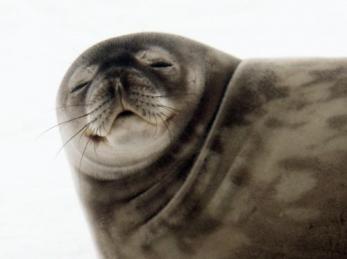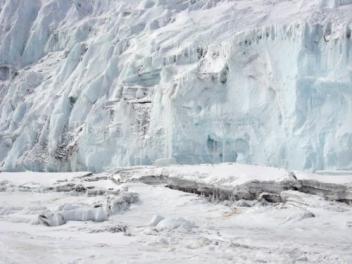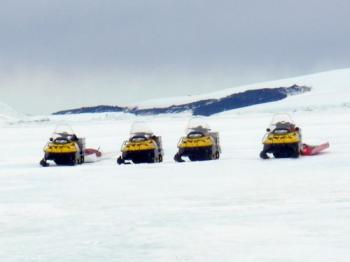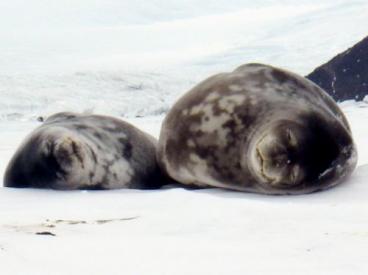December 10, 2007, Monday McMurdo Station, Antarctica 2:00pm High: +32F wind chill: +21F Low: +18F wind chill +7F Winds: S8- 12 knts; Station Pressure: 28.7800” Present Conditions: Partly cloudy, mild temperatures, prevailing low pressure system
Saturday we were supposed to fly out to Cape Bird to take a control set of soil samples and as a side benefit see the penguin rookeries. However, for a second time we were cancelled because of clouds hanging between an area known as the saddle, the pass between Mt. Erebus and Mt.Terror. Apparently NSF does not allow the helicopters to fly over water, so if the passage between the 2 mountains is clouded over the helicopters can not fly in that direction. Andrew was able to convince Marcus Horning to take April and myself out to his seal research station. Not only were we going to see seals we had to get there by skidoos/ snow mobiles. One of the Italian geologists with Andrill came with us as well. He used to teach at Rice and the UH in the 1980’s so he was asking me a lot about Houston today.
The skidoos were incredible. Marcus had us trying to keep up with him and he was pushing 80kmh. He said he usually goes about 100kmh After realizing I wasn’t going to go flying off of it, I couldn’t turn it over, and the concept of a highway was a bit sketchy at best I was able to keep up. It was a blast! It was like trying to drive a car in a video game- very fortunate that going in a straight line was not the way to drive it. We probably were about 40 miles away from McMurdo near the edge of the sea ice and Barne GlacierA mass of ice that persists for many years and notably deforms and flows under the influence of gravity. and the Erebus GlacierA mass of ice that persists for many years and notably deforms and flows under the influence of gravity.. Since we were not with the recreation department and in much lighter vehicles we were able to get very close to the glacial edges and pressure ridges which were the areas where the seals would come up through.
The seals are odd creatures. They can hardly move on land, yet they are graceful and swift under the water. The seals that Marcus is working with are all nursing mothers and pups. His research is centers around the ability for the seal to transform oxygen underwater, migration and aging. All of the seals in the area have been tagged and are part of several different studies that are beginning to wrap up for the season due to the breakup of the sea ice. Marcus also tracks the seals and many of them have a rf transmitter, and a data logger that logs their breaths, blood gases and roaming behaviors.
I am so animal deprived that I found myself recognizing my own dogs facial actions in the seals. Pathetic! Below are some of my favorite pictures of the seals.

just say fish!!

edge of the sea ice and the glacial wall

These go really fast!!!!

She has been on a diet, she spent the last 6 weeks feeding her pup

Saturday afternoon nap on the couch with the baby!


Comments